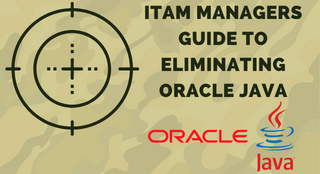Ouch! Oracle Java licensing switches to employee count metric
Update added 7 February 2023: In response to this unprecedented move, the ITAM Review has prepared an ITAM Managers’ Guide to removing Oracle Java and Cost Calculator. We have already heard real-world estimates of between 2x – 10x cost increases form this change. Oracle Java is now a multi-million-dollar line item in your IT budget and therefore requires immediate attention and action.
Original article: As of January 23, 2023 Oracle have changed the licensing model for Java. Formerly based on “Named User Plus (NUP)” for client devices and “Processors” for servers, Oracle Java is now licensed based on the “employee” count of an organisation. Depending on how many employees you have, this switch to Oracle Java licensing based on employee count could get expensive quickly.
What is an employee?
Oracle define an employee as your:
- Full-time employees
- Part-time employees
- Temporary employees
and also those same categories of your:
- Agents
- Contractors
- Outsourcers
- Consultants
That “support your internal business operations”.
For some organisations, clarifying the first half of that will take some work but working out the 2nd half – the total number of employees at your 3rd-party partners who support your business – is going to be easier said than done!
Oracle also clarify that you have to license ALL such employees, not just those that use Java, so the minimum order has to be equal – at a minimum – to the total number of employees at the order date.
Finally, should you find yourself installing Java on more than 50,000 processors, you’ll need to acquire an additional license from Oracle.
New Oracle Java pricing based on employee count
The current pricing tiers are:
| Quantity | Monthly cost |
| 1 – 999 | $15 |
| 1,000 – 2,999 | $12 |
| 3,000 – 9,999 | $10.50 |
| 10,000 – 19,999 | $8.25 |
| 20,000 – 29,999 | $6.75 |
| 30,000 – 39,999 | $5.70 |
| 40,000 – 49,999 | $5.25 |
For large organisations, this seems as though it will quickly make Oracle Java unfeasibly expensive. If you have 40,000 employees your Java cost will now be $210,000 per month…which is just over $2.5 million annually. The move from licensing just the users/processors to the need to license everyone will likely see significant increases for many organizations.
Next steps
The switch from the current Oracle Java model to licensing based on employee count will not be easy. Start by determining your applicable employee count and work out how much your Oracle Java bill will be under the new rules. Once you’ve picked yourself up off the floor, take a look at 3rd party Java alternatives including:
And there are others out there too.
Of course, it won’t be a simple process to migrate from Oracle Java to a 3rd-party alternative, but it may well be the most fiscally responsible option – particularly in the current climate. Once you have support pricing options from a few alternative options, talk to your stakeholders.
Tell them what has changed, the monetary impact, and the likely timescale and get their input on what would be involved in a swap-over i.e. how long it will take and what resources it will require etc. Once you have all that, take it to your leadership team. Highlight it as a potential imminent financial risk, outline the options, and get their buy-in and support for a course of action.
Further Reading
You can download the Oracle price list here: https://www.oracle.com/us/corporate/pricing/price-lists/java-se-subscription-pricelist-5028356.pdf
Other recent articles about Oracle licensing and audits
NASA overspends on Oracle by $15m, SAM practices branded as “basic”
Software and licensing updates for IBM, Micro Focus, Oracle
3 customer examples of increased Oracle audit activity in 2022
Can’t find what you’re looking for?
More from ITAM News & Analysis
-
ITAMantics - April 2024
Welcome to the April 2024 edition of ITAMantics, our monthly news podcast where we discuss the biggest ITAM stories from the last month. George is joined this month by AJ Witt and Ryan Stefani. Stories tackled ... -
Broadcom is removing expired VMware licences from its portal - take action now!
Hot on the heels of Broadcom’s announcement of the end of perpetual licences for VMware it has given customers barely a week to download any keys for licenses from its portal with expired support. This is ... -
Who Loses When Broadcom Wins?
News of a new Broadcom deal rarely arrives with great fanfare. The November 2023 VMware acquisition provoked open worry online and in business circles, with many critics wondering whether the former Hewlett-Packard spinoff’s reputation would prove ...
